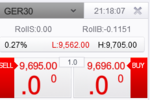Jason Rogers
Senior member
- Messages
- 2,772
- Likes
- 93
Hi Jason, thank you for sharing this information.
Could you clarify the meaning of the Transactions window in Market Behaviour Indicators? What are the units on the y-axis and what is the meaning of 1,038?
Many thanks in advance,
George
Hi George,
The Transactions Indicator shows the sum of individual tickets executed during a specified period.
For example:
- Client A opens 10K EUR/USD, closes 10K EUR/USD = two transactions
- Client B opens 10K EUR/USD, closes 5K EUR/USD, closes 5K EUR/USD = three transactions
- Total Transactions: Five
Below is a video walkthrough of FXCM's five new volume-based indicators: Real Volume, Transactions, Directional Real Volume, On Balance Real Volume and Market Movers Index.






